Other than constipated goldfish, “swim bladder disease” is a very common home diagnosis. Or the more common vernacular, “My fish has swim bladder.” Well, almost all pet fish species have swim bladders, so that fact is correct, but it is not a disease. “Swim bladder disease” is most common in goldfish and koi, with a high percentage in fancy varieties of goldfish. Learn more about what can cause swim bladder disease and how you can help your fish.
Anatomy of Buoyancy in Fishes
Fish are able to stay neutrally buoyant in the water column, not sink or float, due to their swim bladder organ. Depending on the species of fish, they may have one chamber or two. It may be centralized or run along their entire body. In koi and goldfish, they have a two chambered swim bladder that sits centrally and lies just under their spine. You can note the swim bladder in the radiographs, or x-rays, below.
Koi and goldfish are physotomous fishes, meaning they inflate their swim bladder by swallowing air. This air is moved from the esophagus to the swim bladder via the pneumatic duct. The pneumatic duct that brings in air connects in between the two chambers of the swim bladder. Air is removed from the swim bladder via the oval organ. This organ relies on localized pH shift to diffuse air from the swim bladder back into the blood stream.
Physoclistous fishes, such as bettas, use a different organ to inflate their swim bladder. Here is more information on betta fish with swim bladder disease.
Swim Bladder Disease in Koi
For 99% of koi, poor water quality is the cause of swim bladder disease. I have very few cases of actual swim bladder disease in ONE case, shown below.
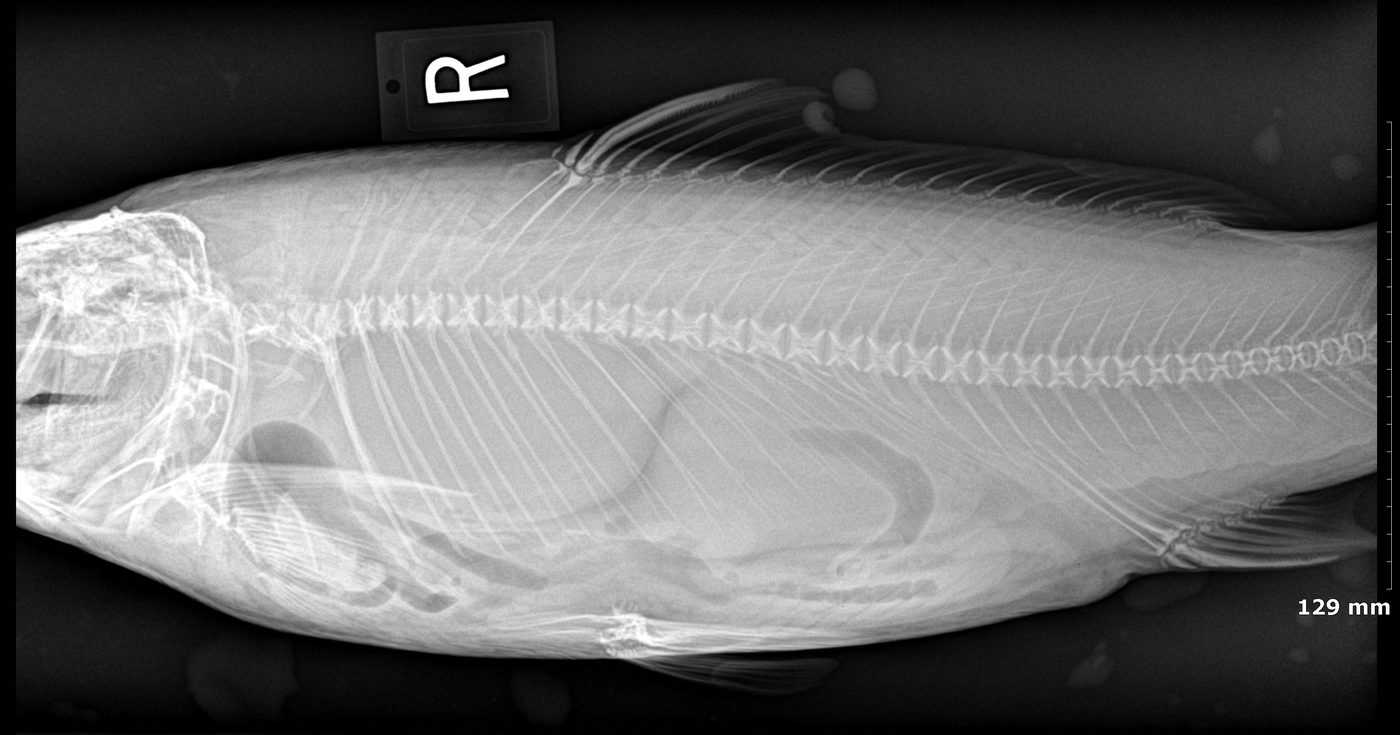
For this koi, her swim bladder is full of urine and acting as a rudimentary urinary bladder, which koi do not have. We don’t know why this happened, but it causes her to scoot around on her belly. But this is our ONE case of an actual swim bladder issue in a koi. We have had two instances of koi with tertiary swim bladders, but not causing any clinical signs.
Swim Bladder Disease in Goldfish
For goldfish, 90% of our “swim bladder” cases are lethargy secondary to poor water quality. Most of our actual swim bladder cases are fancy goldfish with most likely structural deficiencies. We’ve illustrated this point previously with our case on red moor, Huxley. Compare this comet x-ray below…

To these fancy goldfish…
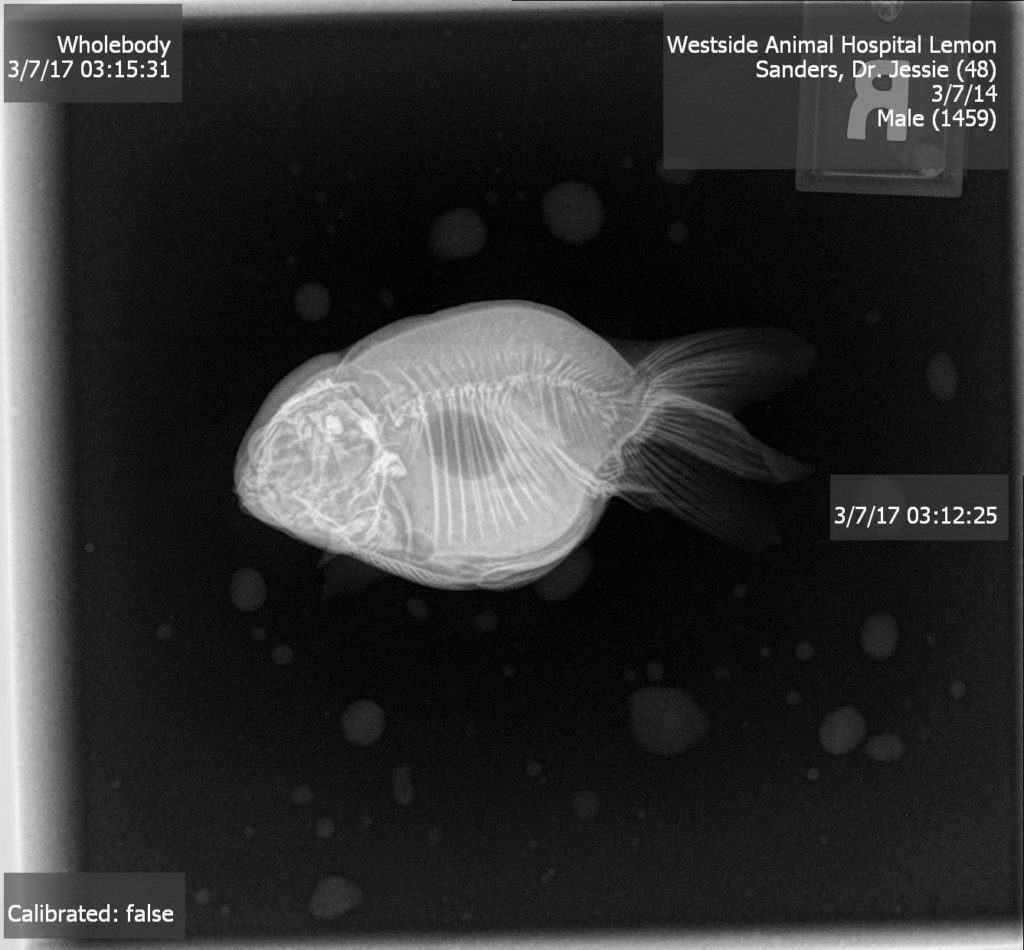
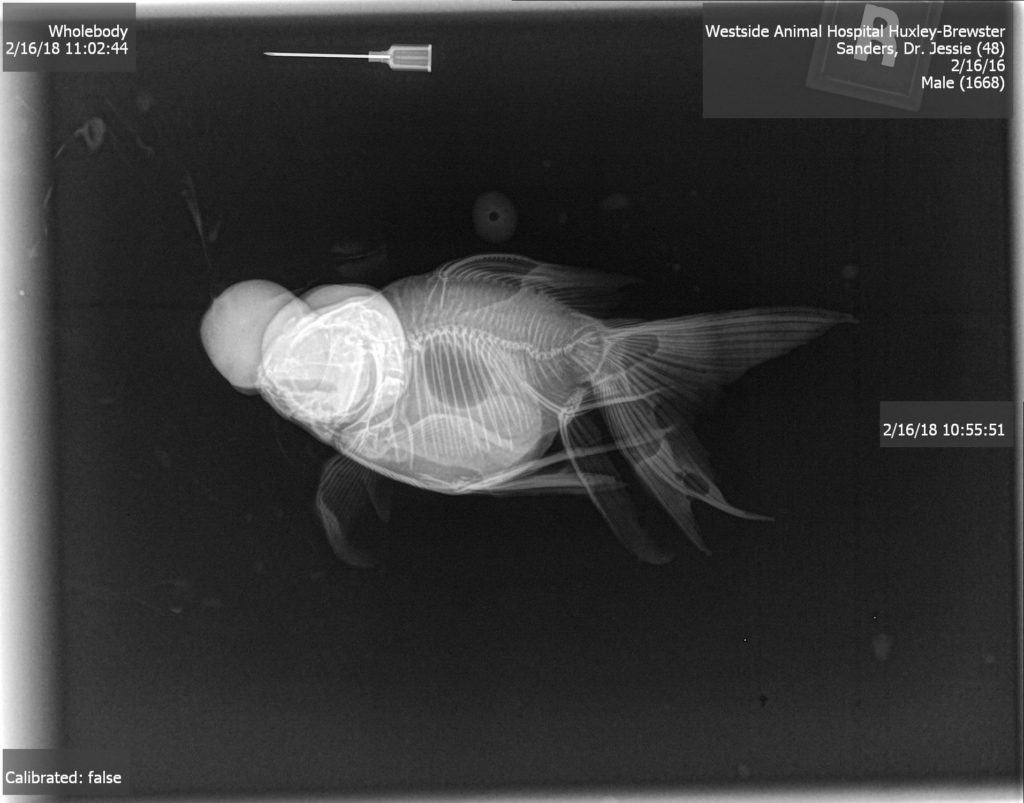
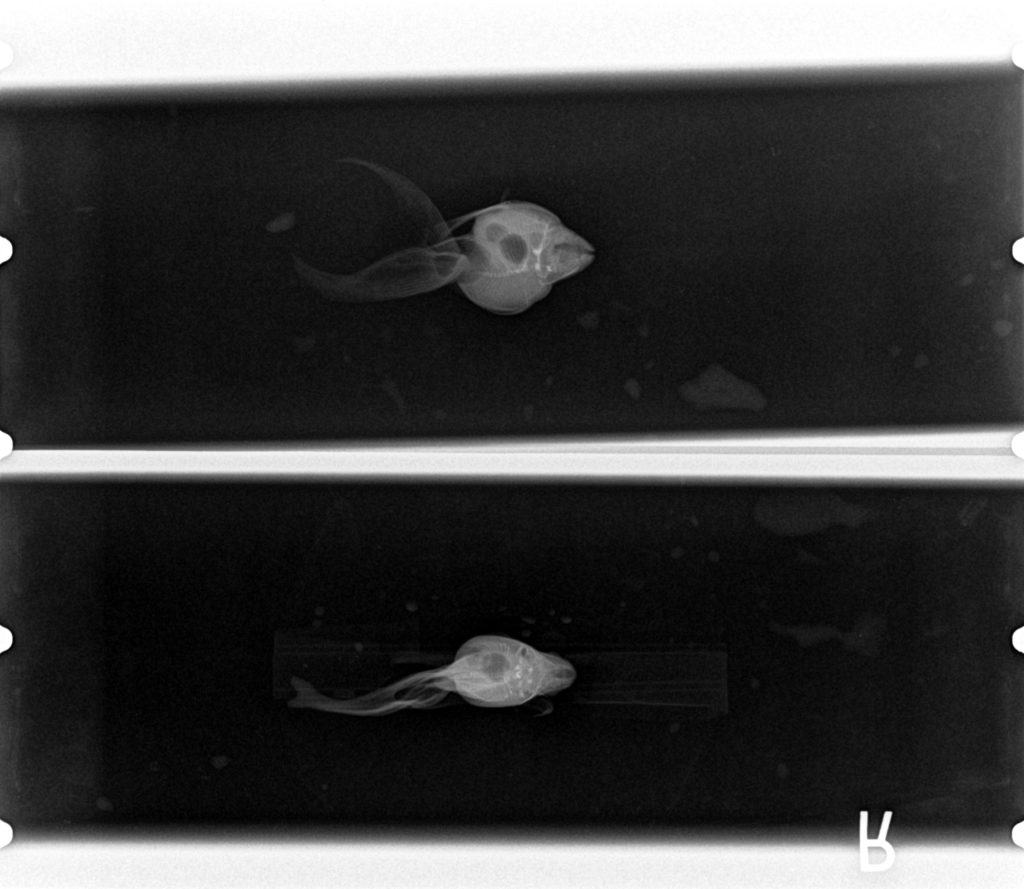
Goldfish are supposed to have a two chambered swim bladder, but due to their anatomy, these fancy varieties have limited space in their coelomic cavities. This sets them up for buoyancy issues from birth.
Positive Buoyancy Disorders
Remember, goldfish and koi are also physostomous fish, meaning that they inflate their swim bladders by having a pneumatic duct between their esophagus and swim bladder. When they eat at the surface, it encourages air to enter the swim bladder and intestines. This is the main reason we see floating fish with swim bladder issues. Goldfish are prone to positive buoyancy disorders because they are voracious eaters, sucking in lots of air at feeding time.
Radiographs, like those above, are critical to diagnosing swim bladder disease versus a gassy fish (air in the GI tract – aka fish farts). Gas in the intestines will slowly move out of the fish, but may need some encouragement. If there is no gas in the intestines, there is likely a primary problem with the swim bladder.
However, being positively buoyant is more critical than being negatively buoyant. Air ulcerations can occur when a fish is stuck at the surface for extended periods of time and their skin erodes due to the loss of their outer protective mucus. This occurs where the skin starts to break down by being exposed to long periods of air allowing infection to set in.
Negative Buoyancy Disorders
9 times out of 10, fish with negative buoyancy disorders are simply lethargic from poor water quality or not enough to eat. Water quality testing and dietary evaluation by your veterinarian can help solve these issues without having to put your fish through the additional stress of an exam.
Fish with primary negative buoyancy may not have enough room in their body to support a larger swim bladder. This is common in fancy goldfish varieties who only have one swim bladder chamber to support their large frame. Issues with anatomy are very hard to correct for the long term.
Fixing Buoyancy Disorders in Pet Fish
If your fish is showing signs of negative or positive buoyancy, CHECK YOUR WATER QUALITY FIRST. Many times, fish with buoyancy disorders are simply stressed from poor water quality. Fix the water chemistry issues and your fish will likely correct themselves.
Fish with swim bladder disorders also need more to eat. They work so hard and burn so many extra calories to correct themselves that secondary lethargy is very common. Your goldfish may need supplemental feeding in order to provide adequate nutrition, which can be discussed with your aquatic veterinarian.
If your water quality checks out and your diet is appropriate, proceed to the options below:
How to Fix a Floating Fish with Swim Bladder Issues
Many floating fish issues are fixed with one simple step: stop feeding floating pellets. Cut off their surface air intake by switching to a sinking pellet and your fish will avoid being gassy and floaty after mealtime. Here is the sinking pellets we prefer. Heavy stocking densities, with lots of competition during feeding time, can exacerbate buoyancy issues. Either move some fish out of the tank or spread out the food more.
And yes, here’s where those “magic” green peas come in. No, it’s not from fiber (your fish can’t digest it), but they are healthy and they SINK!
If the above fix doesn’t work, your fish likely has an overinflated swim bladder or persistent gas in the GI tract. Your veterinarian will assess from radiographs the best method to proceed.
How to Fix a Sinking Fish with Swim Bladder Issues
Most fish pellets will float, which is exactly what you need for sinking fish. If you are feeding flakes, just don’t. They foul your water, go rancid quickly and your fish are better on pellets. Here are our favorite floating goldfish pellets.
External floats, such as those praised on YouTube, must be designed with the fish’s external surface in mind. Anything that rubs up against the skin will disrupt the protective mucus coat and cause secondary infection and rupture the coelomic cavity. Most of those cute fish “wheelchairs” are actually deadly and can seriously harm fish.
Therefore, any float attachment will be TEMPORARY. We only apply them to get fish the surface to naturally inflate their swim bladder. We can take air out surgically, but we cannot add it in case the swim bladder ruptures. Adding a temporary float takes advantage of your fish’s own anatomy and physiology, like for these fish, named Lemon and Rusty. Do NOT add a float without proper surgical prep in order to minimize infection. This procedure should only be undertaken by a veterinarian.
Swim Bladder Disease Can Be Permanent
And that is okay! If your fish scoots along on the bottom of their tank or spends some of their day at the surface, but is perfectly happy otherwise, I’d count it for a win. We have many patients with permanent swim bladder disorders who live long, happy lives being bottom-dwelling or floating fish. If your fish just can’t make a full recovery, here are a few things you will need to change:
- Get rid of your gravel or sand substrate. A fish sitting on this type of substrate all the time will increase their chance for a bacterial infection. Go with a bare bottom tank or glass beads.
- Maintain pristine water quality. Your fish is dealing with other issues in life, don’t make water quality one of them.
- Hand feed your fish a high quality diet. If you have other fish in the tank, you may want to teach them how to target feed or pull them into a small container (still within their main tank) for feeding time.
- Bubble wrap (small size) on 2/3 to 3/4 of the water surface. Do not place it to block your filter outflow, but this will keep your positively buoyant fish moist if they are stuck floating for a short period of time, maintaining their important slime coat.
Final Thoughts on Swim Bladder Disease
If your fish is showing signs of negative or positive buoyancy, CHECK YOUR WATER QUALITY FIRST. Only 10% of our goldfish cases are primary issues concerning the swim bladder. The other 90% are water quality, diet, maintenance or trauma.

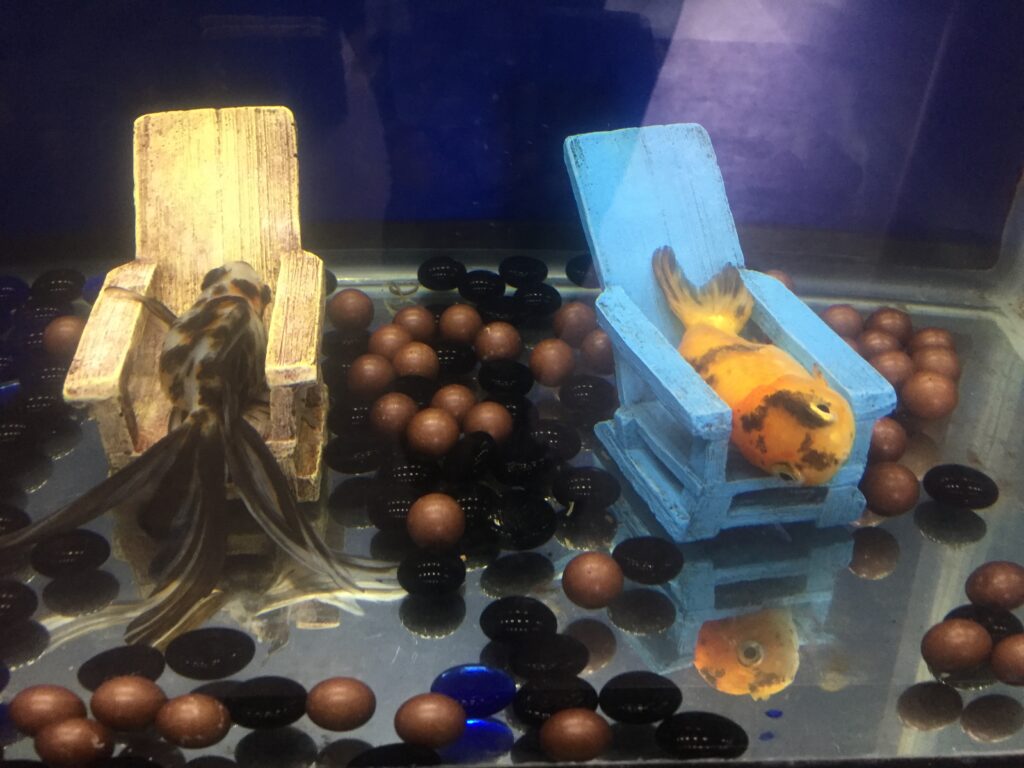
Pingback: The Goldfish Wheelchair and Other Aquatic Veterinary Procedures – Smokey's Science
Pingback: White Stringy Poop in Fish - Aquatic Veterinary Services
My goldfish is very small and it keeps sinking to the bottom of the sank. Its mouth is starting tu be black a little and it does not eat very much It goes to the top of the tank to the water surface but vertically. We thought she had swim bladder so we tried peas but it doesnt seem to help. We think our water is clean enough. Does she have ammonium poising?
You should check your water chemistry and contact your local aquatic veterinarian https://fishvets.org or https://wavma.org
I have a koi with would be 3 inches and I have seen it’s stomach bulging. We thought it got pregnant then, now it does swim it’s just not going to the floor but it’s trying. Can I save it some how?
If you are concerned about your fish, please call (831) 278-1081 for veterinary assistance. If you are outside California and Nevada, please visit https://fishvets.org or https://wavma.org
My fish looks bloated and is floating upside down. It also has a red spot on its belly what should I do?
To find an aquatic veterinarian near you, if you are not in our service area (CA & NV), visit https://fishvets.org or https://wavma.org
I have an oranda that recently started laying at the bottom of the tank. My parameters are all in check. Ammonia 0, nitrites 0 nitrates 5-7, ph 7.5, water temp 72-75. I do many water changes to constantly keep the tank clean. I have 3 orandas, 1 black moor and one other fancy tail goldfish in a 70 gal tank. All 5 fish eat happily and socialize . Once their done eating my biggest oranda starts laying on the bottom but will swim around when he or she sees me. No clamped fins, no nothing. Just stays to the bottom often. Any help would be greatly appreciated.
To find an aquatic veterinarian near you, if you are not in our service area (CA & NV), visit https://fishvets.org or https://wavma.org
Why Toledo goldfish float in the water?
If you are concerned about your fish, please call (831) 278-1081 for veterinary assistance. If you are outside California and Nevada, please visit https://fishvets.org or https://wavma.org
Hi, my koi pond nitrates went out of control causing a devastating overnight fish kill (kid mistakenly fed them dog food). 20 died, 6 survived, of which 2 seem to have permanent swim bladder issues; they lie on their sides on the bottom, for 3 days now. When touched, they swim maniacally around in twists and circles, then lie down again. I have no koi expert support in country. Does this sound like a permanent issue, and a kindness would be to cull them? Or is there any possible way to help them? Reading your article it seems something has ruptured. Both are about 30cm in size; small to medium, around 5yrs old.
If you are concerned about your fish, please call (831) 278-1081 for veterinary assistance. If you are outside California and Nevada, please visit https://fishvets.org or https://wavma.org
I have experienced this and many others as well. Why do koi gulp are and then release it swimming down?
Koi are also physostomous fish, relying on ingesting air to inflate their swim bladders, although some just seem to like the sensation of blowing air bubbles.
I meant air not are.
Pingback: Epsom Salt Bath for Betta Guide And FAQs
Pingback: Swim Bladder Disease Symptoms & Treatment For Your Fish
My male betta( blue) has like a bump or a wart growth on its back by top and its had swim bladder for months hes starting to look bad and loosing his beautiful color and fluffy now he just floats sideways. Ive tried the pea treatment but he will not eat it even after 3 days of not eating. He is still eating hearty and doing the bubbles thing often. Im so sad its getting bad.
If you are concerned about your fish, please call (831) 278-1081 for veterinary assistance. If you are outside California and Nevada, please visit https://fishvets.org or https://wavma.org
Help. I have a silver dollar which is displaying swim bladder problems. I have started treatment, but if I can support him from battling to swim, will it help
If you are concerned about your fish, please call (831) 278-1081 for veterinary assistance. If you are outside California and Nevada, please visit https://fishvets.org or https://wavma.org